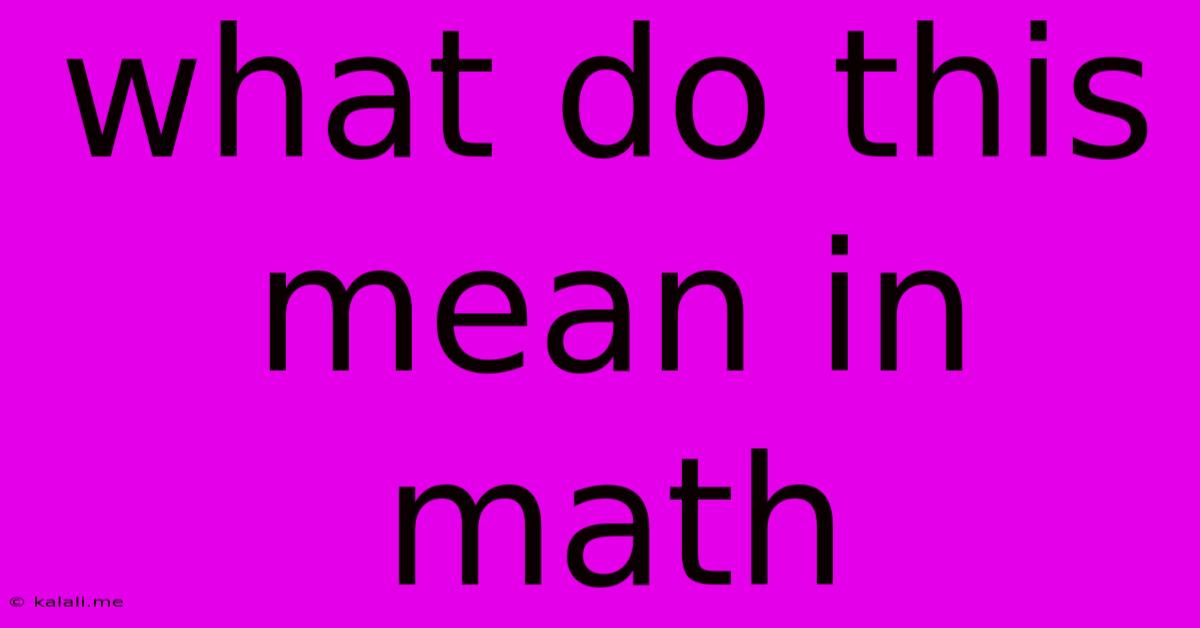What Do This Mean In Math
Kalali
May 31, 2025 · 3 min read

Table of Contents
What Does This Mean in Math? Decoding Mathematical Symbols and Expressions
Understanding mathematical notation is crucial for anyone hoping to delve deeper into the world of numbers and equations. This article aims to demystify common mathematical symbols and expressions, helping you decipher their meaning and apply them effectively. Whether you're a student struggling with a particular concept or simply curious about the language of mathematics, this guide will provide clarity and enhance your mathematical literacy. This exploration will cover a range of symbols, from basic arithmetic operators to more complex notations used in algebra, calculus, and beyond.
Basic Arithmetic Operations: The Foundation
The foundation of mathematical notation lies in basic arithmetic operations. These symbols are universally understood and form the building blocks for more advanced concepts.
- + (Plus): Indicates addition. For example, 2 + 3 = 5.
- - (Minus): Indicates subtraction. For example, 5 - 2 = 3.
- × or ⋅ (Times): Indicates multiplication. The symbol '×' is commonly used in elementary mathematics, while '⋅' is preferred in more advanced contexts to avoid confusion with the variable 'x'. For example, 2 × 3 = 6 or 2 ⋅ 3 = 6.
- ÷ or / (Divided By): Indicates division. '÷' is frequently used in elementary mathematics, while '/' is more common in higher-level mathematics and programming. For example, 6 ÷ 2 = 3 or 6 / 2 = 3.
Essential Symbols in Algebra and Beyond
Moving beyond basic arithmetic, algebra introduces a new set of symbols and notations that represent variables, relationships, and operations.
- = (Equals): Indicates equality between two expressions. For example, x + 2 = 5.
- ≠ (Not Equals): Indicates inequality between two expressions. For example, x ≠ 5.
- < (Less Than): Indicates that one value is smaller than another. For example, 2 < 5.
- > (Greater Than): Indicates that one value is larger than another. For example, 5 > 2.
- ≤ (Less Than or Equal To): Indicates that one value is smaller than or equal to another.
- ≥ (Greater Than or Equal To): Indicates that one value is larger than or equal to another.
- x or y (Variables): Represents unknown quantities or values.
- ( ) (Parentheses/Brackets): Used to group terms and indicate the order of operations (PEMDAS/BODMAS).
- { } (Braces): Often used to denote sets of numbers or values.
- [ ] (Square Brackets): Can be used for intervals or to indicate closed intervals.
- ∑ (Sigma): Represents summation, indicating the sum of a series of numbers.
- ∫ (Integral): Used in calculus to represent integration.
- ∞ (Infinity): Represents a quantity without bound.
Understanding Mathematical Expressions
Mathematical expressions are combinations of numbers, variables, operators, and symbols that represent a mathematical statement. Understanding how to interpret these expressions is vital for problem-solving.
For instance, the expression 2x + 5 represents a linear equation. The 'x' is a variable, '2' is the coefficient of the variable, '+' represents addition, and '5' is a constant. To solve for 'x', we would need additional information, such as an equation setting 2x + 5 equal to a specific value.
Context is Key
The meaning of mathematical symbols often depends on the context in which they are used. For example, the symbol '+' can represent addition in arithmetic, but it might represent a completely different operation in other mathematical fields. Always pay close attention to the surrounding information to ensure accurate interpretation.
Resources for Further Learning
This article provides a foundational understanding of common mathematical symbols and expressions. For a deeper dive into specific mathematical concepts, consider exploring online resources, textbooks, and educational videos tailored to your learning level and interests. Remember, consistent practice and exploration are key to mastering mathematical notation.
Latest Posts
Latest Posts
-
How To Fix Stripped Screw Holes In Metal
Jun 02, 2025
-
How Do You Know If Meat Has Gone Bad
Jun 02, 2025
-
Why Is Gmod Red Screen Not Showing
Jun 02, 2025
-
Does A Gfci Need A Ground
Jun 02, 2025
-
Cube Why Do I Got Into Corner
Jun 02, 2025
Related Post
Thank you for visiting our website which covers about What Do This Mean In Math . We hope the information provided has been useful to you. Feel free to contact us if you have any questions or need further assistance. See you next time and don't miss to bookmark.